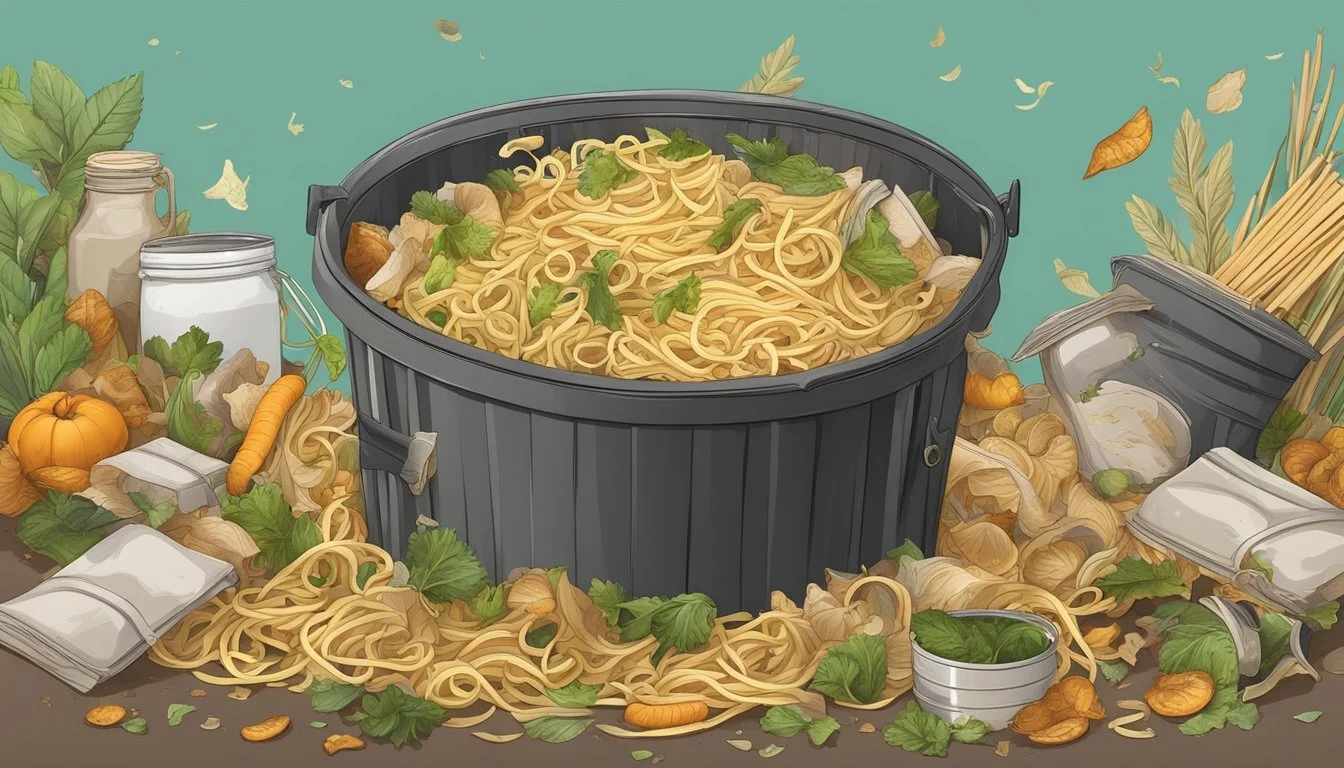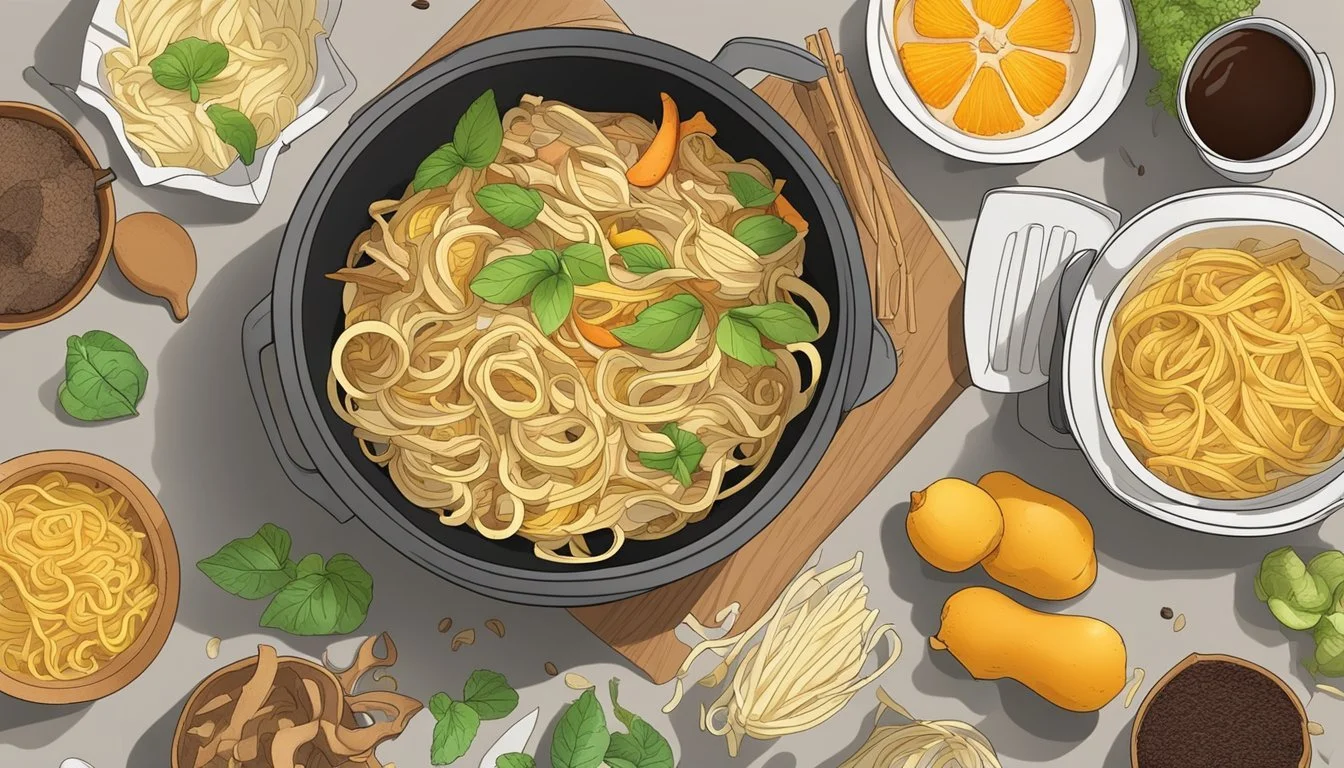Can You Compost Noodles?
Unraveling the Myths and Facts
Noodles are a popular staple in many diets around the world, leading to questions about their suitability for composting. Composting is an effective way to convert organic waste into nutrient-rich fertilizer for gardens, and noodles, as a biodegradable organic matter, can participate in this eco-friendly process. Whether cooked or uncooked, noodles can be broken down by the natural agents in a compost pile, transforming them into beneficial soil amendments.
Adding noodles to compost requires consideration of certain factors to ensure they decompose correctly without attracting pests. Dried, uncooked noodles compost easily due to their simple composition of wheat or rice flour (how long does rice flour last?). Cooked noodles also compost but are prone to attract pests, so they should be added in moderation and ideally mixed with other compost materials to aid in rapid decomposition and to balance the pile's moisture levels.
Compost enthusiasts and gardeners acknowledge the importance of maintaining a diverse mix in their compost bins. By including starchy foods like noodles, they contribute to the creation of a balanced compost pile. Careful management ensures that noodles are effectively turned into valuable compost, contributing to the sustainability loop of consuming and then returning organic materials back to the earth.
Basics of Composting
Composting is an essential process for recycling organic materials and returning vital nutrients to the soil. It reflects an eco-friendly effort to reduce waste and minimize greenhouse gas emissions.
What Is Composting?
Composting is the natural process of recycling organic materials such as leaves, vegetable scraps, and yes, even noodles, into a rich soil amendment known as compost. Microorganisms, primarily bacteria and fungi, break down these materials in the presence of moisture and oxygen. This process, taking place in a compost bin or pile, transforms waste into nutrient-rich soil, perfect for gardening and agriculture. A balance between carbon-rich (brown) and nitrogen-rich (green) materials is essential for effective decomposition.
Benefits of Composting
Composting offers multiple environmental and garden-related benefits:
Waste Reduction: Composting diverts waste from landfills, reducing greenhouse gas emissions, specifically methane, which is a significant environmental concern.
Soil Health: The end product is a nutrient-rich soil that enriches the ground, helping plants grow while also conserving moisture and minimizing the need for chemical fertilizers.
Recycling Nutrients: By returning valuable nutrients to the earth, composting closes the natural nutrient cycle, ensuring the ongoing fertility of soil.
Cost-Effective: It provides an inexpensive alternative to commercial soil conditioners and fertilizers.
Composting is not only a responsible way to handle kitchen and yard waste but also a boon to gardeners and the environment alike.
Understanding Compostable Materials
When it comes to composting, knowing what materials are appropriate for the process is crucial. The right mix ensures efficient decomposition and a nutrient-rich final product.
Organic Matter Types
Compostable organic matter falls into two broad categories:
Green materials: They provide nitrogen, which is essential for the growth of the microbial population that breaks down the compost. Examples include grass clippings, coffee grounds, and vegetable scraps.
Brown materials: These add carbon and aid in creating the necessary air pockets within the compost pile. Common browns are leaves, cardboard, sawdust, and branches.
Both types are vital, balancing the moisture and aeration, and contributing to a successful compost.
Green vs Brown Materials
The optimal compost pile presents a balanced ratio of green to brown materials, commonly recommended at about 1:3. This balance aids in preventing pest problems and foul odors, ensuring a favorable environment for composting.
Greens (Nitrogen-rich):
Grass clippings
Vegetables and fruit scraps
Coffee grounds
Eggshells (in moderate amounts)
Browns (Carbon-rich):
Dry leaves
Cardboard (shredded)
Sawdust (untreated wood)
Branches (chipped for faster decomposition)
Items to Avoid in Compost
Certain items can disrupt the composting process or harm the end product:
Meat, dairy, and bones: Attract pests and can cause odor issues.
Oily or fatty foods: Disrupt the breakdown process and attract pests.
Treated wood sawdust: May contain harmful chemicals.
Yard trimmings treated with pesticides: Can kill beneficial microorganisms and persist in the compost.
These items are not only potentially detrimental to the health of your compost, but they may also pose risks to plants and animals when the compost is used. It's best to keep them out of the compost bin to ensure a healthy ecosystem within the pile and the surrounding environment.
Composting Noodles and Pasta
Composting noodles and pasta (What wine goes well with pasta?) can contribute valuable organic material to compost piles, turning kitchen scraps into nutrient-rich soil. The process differs slightly depending on the state and ingredients of the pasta.
Cooked vs Uncooked Pasta
Cooked pasta provides starch and moisture to a compost pile, aiding the breakdown process. It is important to remember that while cooked noodles can be composted, they should be free of oils and sauces for best results. Uncooked pasta, on the other hand, is also compostable but may take longer to break down due to the lack of moisture.
Pasta with Sauce and Oil
When composting pasta with sauce and oil, it's crucial to consider that high oil content can attract pests. It’s recommended to bury the pasta deeply within the compost to deter animals and mask the aroma. Excessive oil and sauce can also unbalance the compost's moisture levels, so moderation is key.
Handling Meat and Dairy Contamination
Pasta or noodles that have been mixed with meat or dairy should generally be avoided in compost. Meat and fish scraps can lead to unwanted odors and pests. Dairy products can create similar issues. If pasta contains these contaminants, it might be best to leave them out of the compost bin.
Composting Dry and Fresh Pasta
Both dry and fresh pasta (how long does fresh pasta last?) fall under the category of compostable materials. Dry pasta, being a raw starch source, will slowly soften and decompose over time. Fresh pasta, already hydrated, will incorporate more readily into the compost. In both instances, breaking them into smaller pieces will hasten their integration into the compost.
Factors Affecting Decomposition
Decomposing noodles in a compost setup is influenced by specific factors that govern the breakdown rate of organic materials. Attention to these variables ensures efficient composting.
Optimizing Moisture Levels
The moisture content in a compost pile is crucial, as it should be maintained at a level similar to a wrung-out sponge. This optimal moisture level facilitates microbial activity without causing waterlogging, which can slow down the decomposition process or lead to anaerobic conditions.
Ideal moisture content: 40-60%
How to measure: Feel-test or use a moisture meter
Regulating tips:
Add dry yard waste to absorb excess moisture
Water the compost if it's too dry
Temperature and Aeration
Decomposition accelerates in a warm environment, with the ideal temperature range being between 135-160°F. Adequate aeration through regular turning with a compost tumbler or other tools provides oxygen necessary for microorganisms to thrive and helps maintain the pile's temperature.
Monitor temperature: Use a compost thermometer
Aeration tips:
Turn the pile every 1-2 weeks
Ensure the compost is well-ventilated
Role of Microorganisms and Pests
Microorganisms such as bacteria and fungi are the powerhouse of composting, breaking down organic matter into humus. Infestations of unwanted pests can be minimized by proper compost management.
Encourage microorganisms:
Maintain neutral pH and balance green and brown materials
Manage pests:
Bury food scraps deep to deter pests
Use a compost bin with a lid to keep pests out
Managing Composting Challenges
When composting noodles, one must navigate potential issues such as pest attraction, odor development, and decomposition inefficiencies. The following subsections will address these challenges specifically and suggest practical solutions.
Preventing Pests and Odor
Noodles can attract pests like rats and raccoons due to their high starch content. To prevent pest problems, it's essential to bury noodles deep within the compost pile and cover them with browns like leaves or straw to mask the scent and make it less accessible. Unpleasant odor, a sign of bacterial overgrowth, can be controlled by maintaining the right balance between greens and browns to ensure a healthy compost microbial environment.
Addressing Attractants:
Bury noodles ***
At least 10 inches deep
Under browns (dry leaves, straw)
Maintain balanced composition
Ideal green to brown ratio: 1:3
Avoiding Clumping and Poor Aeration
In a compost pile, noodles may clump together, impeding airflow and slowing down the decomposition process. To prevent clumping, break noodles into small pieces before adding them to the compost. It's also beneficial to turn the compost regularly, which helps distribute air and moisture evenly, fostering a faster breakdown of material.
Enhancing Decomposition:
Break noodles into smaller pieces
Turn compost pile to:
Improve oxygen circulation
Even out moisture levels
Dealing with Slow Decomposition
The decomposition rate for pasta can vary; it typically breaks down within a few weeks to a couple of months, depending on the conditions. To expedite the process, one should ensure adequate moisture levels without over-saturation. If decomposition is unusually slow, evaluating the compost mixture for imbalances in nitrogen and carbon sources or assessing the pile's temperature may be necessary.
Accelerating Breakdown:
Check moisture levels: damp, not soggy
Adjust compost mixture:
If too wet: add more browns
If too dry: add greens or water sparingly
Monitor temperature for optimal microbial activity
Composting Best Practices
Effective composting of noodles and similar organic matter involves understanding best practices that ensure a balanced and efficient decomposition process. These practices are crucial for maintaining a healthy compost environment that yields nutrient-rich fertilizer.
Appropriate Ratio of Materials
A fundamental aspect of composting noodles, or any food waste, is maintaining the right ratio of green to brown compostable materials. Greens, which include kitchen scraps like cooked pasta, provide nitrogen, while browns, such as dry leaves and yard trimmings, supply carbon.
Green Compostables: Vegetable scraps, fruit waste, grass clippings
Brown Compostables: Dry leaves, branches, cardboard, paper
For optimal results, a compost pile should have a carbon to nitrogen ratio of about 30:1, with more brown materials than green.
Managing a Balanced Compost Pile
A balanced compost pile requires not only the right materials but also proper aeration and moisture. A composting bin should be turned regularly to mix the materials and introduce oxygen, which is critical for breaking down organic matter.
Aeration: Turn the compost pile every week to ensure even decomposition.
Moisture: The pile should feel like a wrung-out sponge—moist but not wet.
Monitoring temperature is also important, as a warmer pile indicates active composting. If noodles or other green materials are added, they should be mixed well with brown materials to avoid attracting pests and to accelerate breakdown.
Composting in Moderation
While noodles and other starchy foods can be composted, they should be added in moderation to avoid disturbing the pile's balance. Large quantities of pasta may lead to:
Excessive moisture
Unpleasant odors
Pest attraction
It is advisable to chop or break up noodles and pasta before adding them to the compost to aid in a more uniform decomposition. Similarly, one should be cautious of adding too many cooked noodles at once, as excess oil or sauce can deter the composting process.
Conclusion
Composting is a sustainable practice that reduces environmental impact by converting organic waste into nutrient-rich soil amendments. Noodles, as a compostable material, can effectively be included in this eco-friendly process. When composting noodles, one should chop them into smaller pieces to facilitate more rapid breakdown.
Precautions in Composting Noodles:
Temperature: Avoid adding hot, freshly cooked noodles to the compost to prevent attracting pests.
Balance: Mix noodles with drier compost materials to maintain optimal moisture levels in the compost pile.
Through responsible composting of noodles, individuals contribute to a circular economy where waste is minimized, and resources are reused. This activity not only diverts food waste from landfills but also enriches soil for future plant growth, showcasing a commitment to sustainability.







